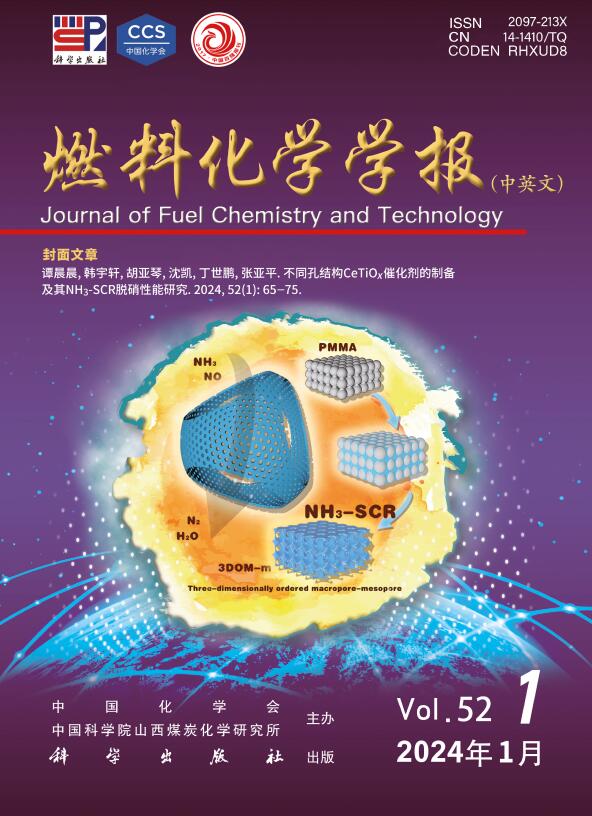High-performance electrocatalytic nitrogen oxidation of two-dimensional MOF based on a rod-manganese motifs
Q3 Energy
引用次数: 0
Abstract
The electrocatalytic nitrogen oxidation reaction (NOR) is a sustainable approach for converting N2 to NO-3 under mild conditions. However, it still faces challenges including inefficient N2 absorption/activation and oxygen evolution competition, sluggish kinetics, low Faradaic efficiency, and limited nitrate yields. In this work, a novel two-dimensional (2D) layered MOF Mn-BCPPy (H2BCPPy=3,5-di(4’-carboxyphenyl) pyridine) has been successfully synthesized. The framework is composed of a rod-manganese motifs and possesses abundant active sites including open metal sites (OMSs) and Lewis base sites (LBSs). The Mn-BCPPy is the first MOF catalyst applied in electrocatalytic NOR which exhibited relatively high activity with a NO-3 yield of 99.75 μg/(h·mg) and a Faraday efficiency (FE) of 32.09%. Furthermore, it can be used as fluorescent sensor for selectively and sensitively detect nitrofuran antibiotics (NFs). Therefore, this work explores the application of MOF materials in the field of electrocatalytic NOR, which reveals that manganese-based MOFs have great potential prospects.
基于棒-锰基的二维MOF的高性能电催化氮氧化
电催化氮氧化反应(NOR)是一种在温和条件下将N2转化为NO-3的可持续方法。然而,它仍然面临着氮气吸收/活化和析氧竞争效率低、动力学缓慢、法拉第效率低和硝酸盐产量有限等挑战。在这项工作中,成功地合成了一种新的二维(2D)层状MOF Mn-BCPPy (H2BCPPy=3,5-di(4 ' -羧基苯基)吡啶)。该框架由一个棒状锰基序组成,具有丰富的活性位点,包括开放金属位点(oms)和路易斯碱基位点(LBSs)。Mn-BCPPy是第一个应用于电催化NOR的MOF催化剂,其NO-3产率为99.75 μg/(h·mg),法拉第效率(FE)为32.09%,具有较高的活性。此外,它还可以作为荧光传感器选择性和灵敏地检测硝基呋喃类抗生素(NFs)。因此,本工作探索了MOF材料在电催化NOR领域的应用,揭示了锰基MOF具有巨大的潜在前景。
本文章由计算机程序翻译,如有差异,请以英文原文为准。
求助全文
约1分钟内获得全文
求助全文
来源期刊

燃料化学学报
Chemical Engineering-Chemical Engineering (all)
CiteScore
2.80
自引率
0.00%
发文量
5825
期刊介绍:
Journal of Fuel Chemistry and Technology (Ranliao Huaxue Xuebao) is a Chinese Academy of Sciences(CAS) journal started in 1956, sponsored by the Chinese Chemical Society and the Institute of Coal Chemistry, Chinese Academy of Sciences(CAS). The journal is published bimonthly by Science Press in China and widely distributed in about 20 countries. Journal of Fuel Chemistry and Technology publishes reports of both basic and applied research in the chemistry and chemical engineering of many energy sources, including that involved in the nature, processing and utilization of coal, petroleum, oil shale, natural gas, biomass and synfuels, as well as related subjects of increasing interest such as C1 chemistry, pollutions control and new catalytic materials. Types of publications include original research articles, short communications, research notes and reviews. Both domestic and international contributors are welcome. Manuscripts written in Chinese or English will be accepted. Additional English titles, abstracts and key words should be included in Chinese manuscripts. All manuscripts are subject to critical review by the editorial committee, which is composed of about 10 foreign and 50 Chinese experts in fuel science. Journal of Fuel Chemistry and Technology has been a source of primary research work in fuel chemistry as a Chinese core scientific periodical.
 求助内容:
求助内容: 应助结果提醒方式:
应助结果提醒方式:


